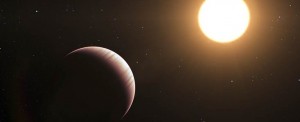Detecting the light from an exoplanet orbiting another star has been compared to trying to see a mosquito on the rim of a headlight ten miles away. But a team of astronomers working in the driest place on earth say they developed a technique to do just that and more:
ESO — But now, after 15 years of attempting to study the faint glow that is emitted from hot Jupiter exoplanets, astronomers have finally succeeded in reliably probing the structure of the atmosphere of Tau Boötis b and deducing its mass accurately for the first time. The team used the CRIRES instrument on the Very Large Telescope (VLT) at ESO’s Paranal Observatory in Chile. They combined high quality infrared observations (at wavelengths around 2.3 microns) with a clever new trick to tease out the weak signal of the planet from the much stronger one from the parent star.
To quote our Vice-President, that’s a big fucking deal. If the technique pans out and can be refined, with more instruments and enhancements coming online at the VLT, or with the help of future space-based observatories like the James Webb Space Telescope, it’s possible we could begin to catalogue the composition and probe the three-dimensional structure of exoplanetary atmospheres in some detail.
What might we find?
Odds are lots and lots of diversity in completely unpredictable forms! The exos themselves have greatly broadened our understanding of just how diverse planetary systems can be. This could do the same for individual planets, opening up a whole new, exciting field of science. If perfected, it could even conceivably detect the telltale chemical signature of exotic oceans and other surface features, or even signs of simple or complex life?
OK, that last one is a hell of a long shot. But it’s still pretty cool!


Did you see this?
http://www.bbc.co.uk/news/science-environment-18412440
and this
http://www.nasa.gov/mission_pages/hubble/multimedia/hubble-moon-venustransit.html
exciting times